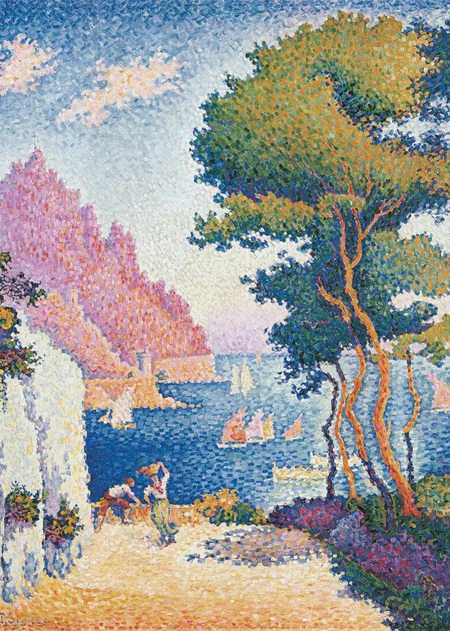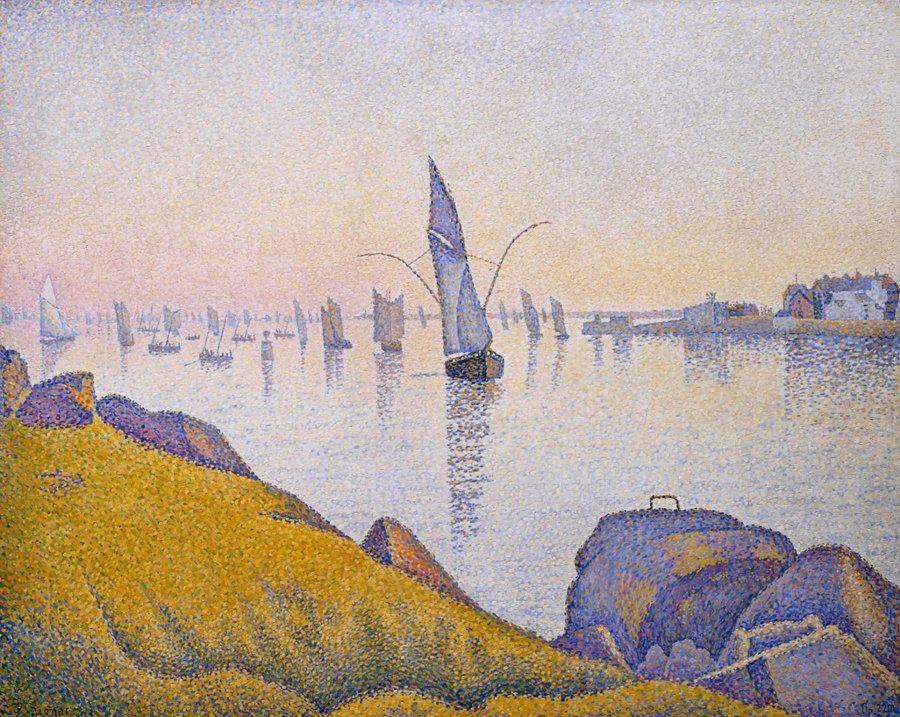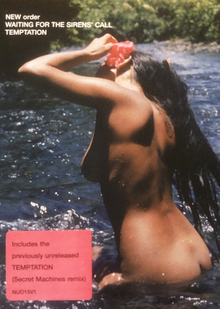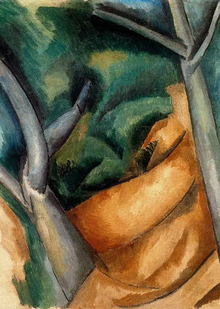
The love of life in the works of Paul Signac
Paul Signac was a French painter of the 20th century (1863-1935) who stood at the origins of pointillism and neo-impressionism. After studying the structure of the eye and the laws of color perception, the artist realized that the perception of colors is enhanced when using small dots of paint, which is why his works are so captivating.
For him, painting was not a difficult task, but rather a joy and an inspired state. This is why most of his works are so warm and cheerful.

«Concarneau» 1891. Oil
The rubricator
1. Concept of the research 2. Graphic techniques 2.1. Color 2.2. Lines and spots 3. Main images in the works of Paul Signac 3.1. Sea 3.2. Trees 4. Conclusion
Paintings by Paul attract attention with their unique brightness, richness of colors, and the accuracy of color transfer. The magic of the sea element is particularly appealing in them. Travelling to various parts of France, from Brittany to the Mediterranean coast, allowed the artist to fully appreciate the beauty and vitality of the water. However, it was only in his permanent retreat in Saint-Tropez that he discovered true peace and inspiration from the unique atmosphere of this remarkable place. The author Vayan Couturier described him as: «Signac loved art, humanity, and the sea.» This quote accurately characterizes the artist.
The author Vayan Couturier described him as: «Signac loved art, humanity, and the sea.» This quote accurately characterizes the artist.
The term «pointillism» was coined in the late 1880s by art historians to describe the works of certain artists, but it has since become the official name for their distinctive style. Georges Seurat painted using small, brightly colored strokes that were placed very close together, creating a contrast between shades that seemed to blend and shimmer when viewed from a distance. This technique relies on the viewer’s eyes and mind’s ability to mix the color spots and create a more harmonious range of tones. Seurat’s works often feature natural landscapes, such as trees, seascapes, and ships.Color plays an important role in painting. The same color can have different tones, and painting is a game of warm and cool shades. It is one of the most powerful tools artists use to communicate their message and evoke emotions in viewers. Colors can significantly impact our mood and emotional state. In a visual analysis, it is important to consider this aspect, using the example of Paul Signac’s paintings.
«Le Diableret». 1903. Oil
The aim of my visual research is to explore the work of Paul Signac and discover the graphic techniques and images he used to convey his love for life in his paintings.
In my work, I analyzed iconic paintings to trace changes, paying attention to the technique of pointillism and how color highlights the truth and inner state of the artist. The visual study includes works from different periods in Paul Signac’s career, from his earliest paintings to his last.
Graphic techniques
2.1. Color
The artist is playing with the palette, using a variety of warm colors to create sensual and vibrant paintings. For example, in «The Port at Sunset, Opus 236» (Saint Tropez), Signac uses the technique of pointillism to capture the dramatic beauty of evening light, with contrasting shades of deep purple and the last rays of the sun.
«The Port at Sunset, Opus 236 (Saint Tropez)». 1892. Oil
«The Port at Sunset, Opus 236 (Saint Tropez)». 1892. Oil
«The Neo-Impressionists strive to capture the radiance of light and the rich colors of nature, drawing from this source of inspiration to create their works. They understand that while they can draw from nature, they must also choose and arrange the elements in their own unique way. A well-composed painting, with carefully chosen lines and colors, will surpass a sketch that merely reflects nature in all its imperfections.»
The combination of yellow and purple can be seen often in the artist’s paintings as they complement each other. Blue and orange also complement each other, so the paintings achieve harmony and contrast.
«Sunset over the city (sketch)». 1892. Oil
«Sunset over the city (sketch)». 1892. Oil
«Saint Tropez. Fountain de Lis». 1895. Oil
«Place de Lis, Saint-Tropez.» 1893. Oil
There are also works that use a small number of colors. However, thanks to the various shades, a diverse image is created. I also want to examine this in detail and carefully. On the canvas of «The Vessel», several majestic ships are sailing on the sea or standing in the harbor. Two of them are fully sailed. With the help of small strokes in the foreground, the artist skillfully conveys the ripples on the water. The scene is filled with pink, lilac, yellow, and green hues of a hazy morning. This creates a peaceful atmosphere, and the work does not seem pessimistic.
«The courts.» 1895. Oil
«The Bank of the Seine in Erbla.» 1889. Oil
2.2. Line and spot
Seurat’s work with wooden planks, where the brush’s touch did not cause vibration, inspired artists to seek new artistic principles. This led to the development of pointillism, where artists used dots instead of traditional brushstrokes. Their experiments with this new technique created clearer and more geometric images. In the 20th century, these ideas continued to influence digital media technology. The Seurat method became the foundation for modern color images in digital communication, starting with television and expanding to other areas.
«Andeli. Chateau-Gaillard». 1921. Oil
«Andeli. Chateau-Gaillard». 1921. Oil
The line and the spot play a significant role in the artist’s work. In many of his works, there is a lack of dynamics, as he seeks to convey a sense of calm and harmony that nature provides. The dominant lines are horizontal to express serenity, ascending to convey joy, and descending to evoke sadness. The use of pointillism in his paintings adds to their attractiveness.
«The railway to Bois-Colombe». 1886. Oil
«The separation technique is a complex system of harmony, more aesthetic than technical. Working with dots, pointillism is just a means to an end. The goal is to find the power and balance of colors in paints, to transmit the colored light through their pure elements, and to use the optical mixture of these individual elements in the right proportions, according to the fundamental laws of contrast and gradation.»
«Masts». 1888. Oil
«The Banks of the Seine.» 1900. Watercolor, gouache, pencil.
«Port-en-Bessin, the coast». 1884. Oil
The main images in the works of Paul Signac
Paul Signac was inspired by nature and its natural beauty more than by man-made objects.
3.1. The sea
One of the main features of the painting is the water element. Each painting depicts the sea in a different way. For example, in «Lombard Bay in the vicinity of Cassis», the sea is completely free. In a letter to Vincent Van Gogh, Brusche wrote: «The white, blue and orange colors harmoniously transform into circles. Even the outline of the waves around the coastline looks like music.» Upon closer inspection, it becomes clear that the artist used these colors to convey information about the state of the sea. The transition from the yellow land to the blue sea represents a combination of life and light. Dotted paint strokes fill the landscape with a sense of pulsation, preventing the viewer from feeling the heat of the day.
1. «Lombard Bay in the vicinity of Cassis» 1889 2. «Juan-le-Pen. Evening» 1914 3. «Port in Saint-Tropez» 1902
«Port buildings, Saint-Tropez» 1892
1. «Cassie. Cape Kanai.» 1889 2. «Portrait. Countess (Opus No. 191)». 1888 3. «Suspension bridge or Barges and tugboat on the river.» 1920
3.2. Trees
In the works of Paul Signac, the image of a tree is often found, filling the canvas with its majestic beauty. In one of his works, the pine tree in Saint-Tropez dominates the landscape with its dense foliage. The artist’s brushstrokes, which are different from pointillism, add volume and texture to the branches and the relief of the ground, creating a mosaic effect. The color palette is more vibrant and contrasting, but the rules of pointillism are still followed, with orange juxtaposed with red, blue with green, and purple. This creates a decorative image that captures the essence of reality in a neo-impressionist style.
1. «The Pine Tree in Saint-Tropez», 1909 2. «Pine», Bonaventure, 1893 3. «Saint-Tropez: Fountain de Lis», 1895
«The Big Pine Tree, Saint-Tropez» 1893
1. «Capo di Noli» 1898 2. «The road from Gennevilliers» 1883
Conclusion
After analyzing the work of Paul Signac, I have come to the conclusion that his paintings contain many bright colors and contrasting landscapes, which give the viewer a sense of optimism and joy. The artist’s inspiration was nature, and his colorful and vibrant works are a reflection of this.
— «Georges Seurat and Paul Signac» Bohemian Xenia
— Maslov A.V. Artistic principles of pointillism and digital media technologies



